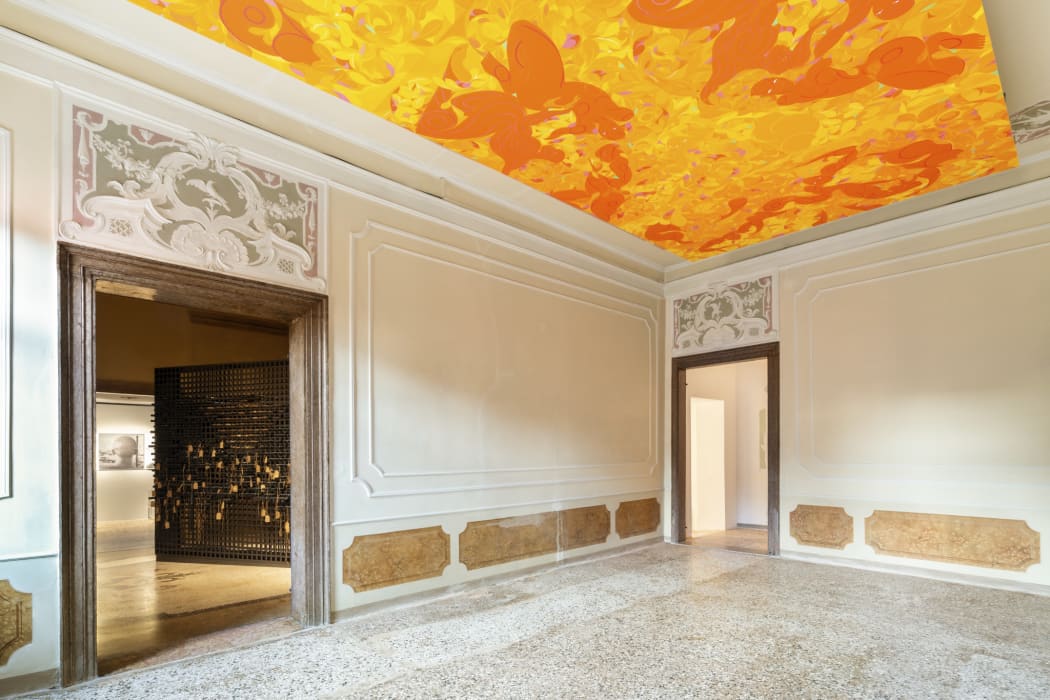
This year's theme, Stranieri Ovunque - Foreign Everywhere, presents a profound opportunity to explore narratives of cultural intersectionality, migration, and globalisation, all of which resonate deeply with the African experience. The excellent curatorial teams and artists selection play a pivotal role in amplifying African voices and perspectives on the global stage.
For this 60th edition, a remarkable number of African nations are making their debut or returning to showcase their artistic talents to the world. In this article, Pavillon54 offers an exclusive glimpse into what lies ahead at this year's Venice Biennale, with a special emphasis on the debut and established participation of African pavilions.
What we’ll cover in this article includes:
- The African Pavilions making their debut at Venice Biennale 2024
- Nigerian Pavilion: Nigeria Imaginary
- South Africa's Resonant Reflections: Quiet Ground
- Wael Shawky to represent Egyptian Pavilion
- Cameroon's Visionary Quest: Nemo Propheta in Patria
- Democratic Republic of Congo: LITHIUM
- Ivory Coast's Melodic Expression: Blue Note
- Kenya's Journey of Cultural Reclamation: Roots of Return
- Uganda's Collective Harmony: WE ARE ONE
- Conclusion
The first appearance of Benin, Ethiopia, Tanzania, and Senegal pavilions at Venice Biennale 2024
Several African countries are participating in the Venice Biennale for the very first time in 2024, including Benin, Tanzania, Senegal, and Ethiopia. Their inaugural pavilions offer a window into the rich artistic expressions and narratives emerging from these nations.
The Everything Precious Is Fragile exhibition marks Benin's historic first participation, curated by esteemed Nigerian art critic Azu Nwagbogu. Featuring artists like Chloé Quenum, Romuald Hazoumè, Moufouli Bello, and Ishola Akpo, the Beninese pavilion promises to inspire the audiences with its exploration of materials, culture, and identity.

Benin Pavilion at La Biennale di Venezia 2024. Image source: OnArt Media
Tanzania joins the global art stage with an immersive presentation by Rangi Gallery’s artists Happy Robert, Lute Mwakisopile, Haji Chilonga, and Naby, delving into the complex relationship between humanity and nature through the lens of the "trickster" figure. Curated by Enrico Bittoto, these contemporary African artists will explore the concept of the "Other," delving into the intricate relationship between humanity and nature through the lens of the trickster archetype – a chimerical figure that acts as a mediator between humans and the divine.

Freedom, Acrylic on canvas, Happy Robert. Image courtesy of Rangi Gallery and the artist
Under the theme "Bokk – Limites" (Limits) and curated by Marième Ba and Massamba Mbaye, Senegal makes its Biennale debut with artist Alioune Diagne's innovative "figuro-abstro" paintings and installations, delving into pivotal topics such as women's roles, discrimination, environmental concerns, and the intergenerational transfer of heritage.
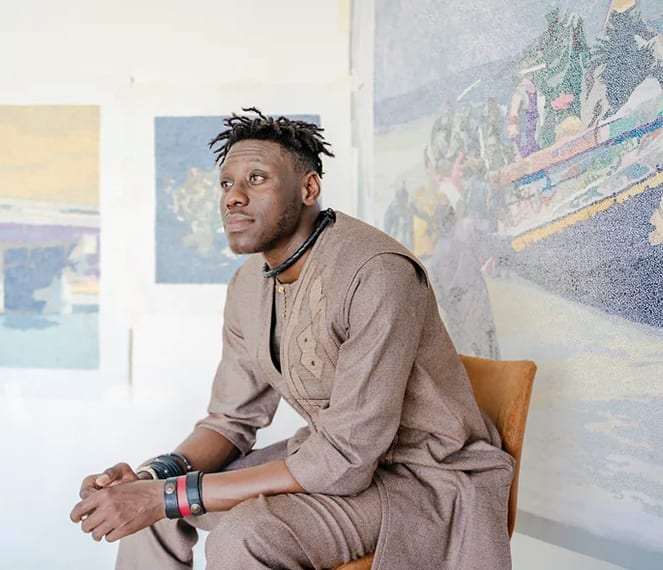
Alioune Diagne. Image courtesy of the artist
Ethiopia's first-ever pavilion, "Prejudice and Belonging," features the compelling works of Tesfaye Urgessa, Ethiopian painter based in Germany, known for his narratives depicting contemporary African society and questions of identity, as for his innovative use of classical and Western aesthetics.
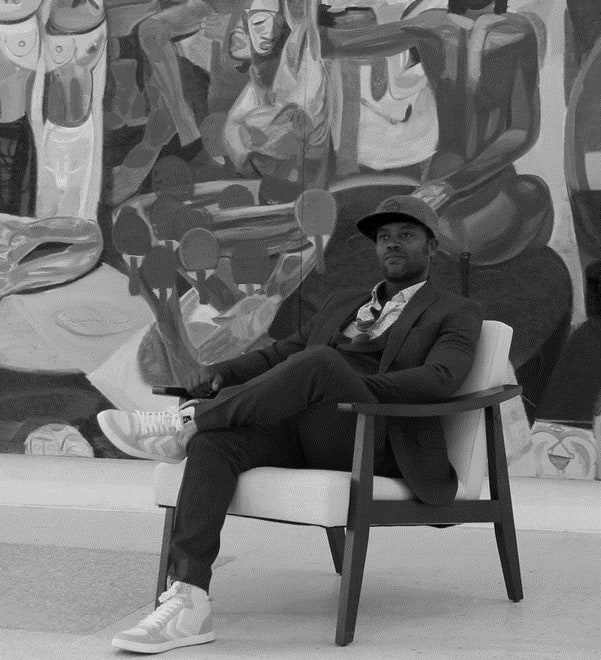
Tesfaye Urgessa. Image courtesy of the artist and the Ethiopian Pavilion
The Moroccan pavilion, initially slated to make its debut at this year's Biennale with its first national pavilion, was embroiled in controversy. In January, the three originally commissioned artists and curator were abruptly replaced by Moroccan authorities, leading the country to desist from having a national pavilion entirely.
Established Voices
Alongside these newcomers, several African nations with a history of participation return to the Venice Biennale, further enriching the global discourse on contemporary art.
Nigeria Makes a Powerful Return to the Venice Biennale
For its second participation in the Venice Biennale, Nigeria is presenting an ambitious and multifaceted exhibition titled "Nigeria Imaginary." Curated by Aindrea Emelife from the Museum of West African Art (MOWAA), the pavilion brings together a cross-generational group of eight acclaimed Nigerian artists from both the homeland and diaspora: Tunji Adeniyi-Jones, Ndidi Dike, Onyeka Igwe, Toyin Ojih Odutola, Abraham Oghobase, Precious Okoyomon, Yinka Shonibare CBE RA, and Fatimah Tuggar.
Through a range of mediums and perspectives, their newly commissioned, site-specific works explore the complexities and dreams of the Nigerian experience.
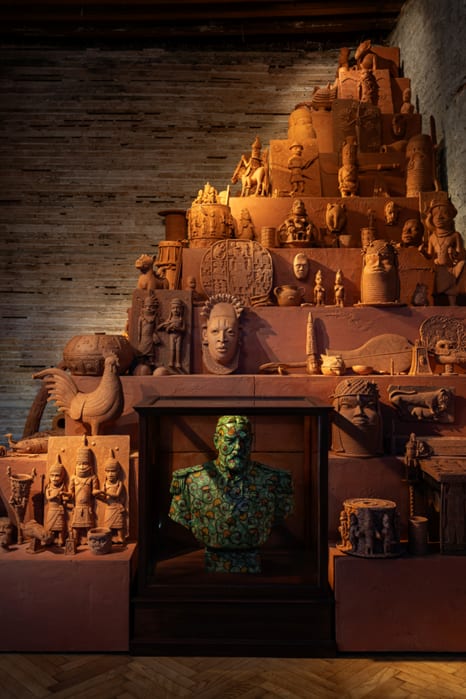
Yinka Shonibare CBE RA, Monument To The Restitution Of The Mind And Soul, 2023. Image courtesy of the artist and MOWAA
According to Emelife, Nigeria Imaginary evokes the spirit of the pioneering Mbari Club, a post-independence centre for cross-disciplinary cultural activities driven by the belief that art was a "duty to the nation." The pavilion reimagines this ethos through the lens of a new generation of artists exploring Nigeria's past, present, and future imaginaries.
South Africa's Resonant Reflections: Quiet Ground
For its 7th participation, South Africa presents "Quiet Ground" curated by Portia Malatjie for the Institute of Creative Repair. It will feature the sound installation Dinokana (2024) by the MADEYOULOOK collective (Molemo Moiloa and Nare Mokgotho), commissioned specifically for the Biennale. This work highlights stories of forced migration and land dispossession in South Africa, tying into the "Strangers Everywhere" (Stranieri Ovunque) theme of the overall Biennale exhibition. The installation explores how dispossessed people are reconnecting with the land through relocation and rehabilitation rooted in indigenous knowledge.

Dinokana Installation. Image courtesy of MADEYOULOOK collective
Wael Shawky's Narrative Realms Representing Egyptian Pavilion
The Egyptian pavilion promises to be a standout, with renowned artist Wael Shawky representing the country. Presented by Lisson Gallery, Barakat Contemporary, Galleria Lia Rumma, and Sfeir-Semler Gallery, Shawky's research-based multimedia practice spans film, performance, painting, and sculpture. His work explores notions of national, religious, and artistic identity, narrating stories that intertwine fact, fiction, and fable, inspired by historiographical and literary references.
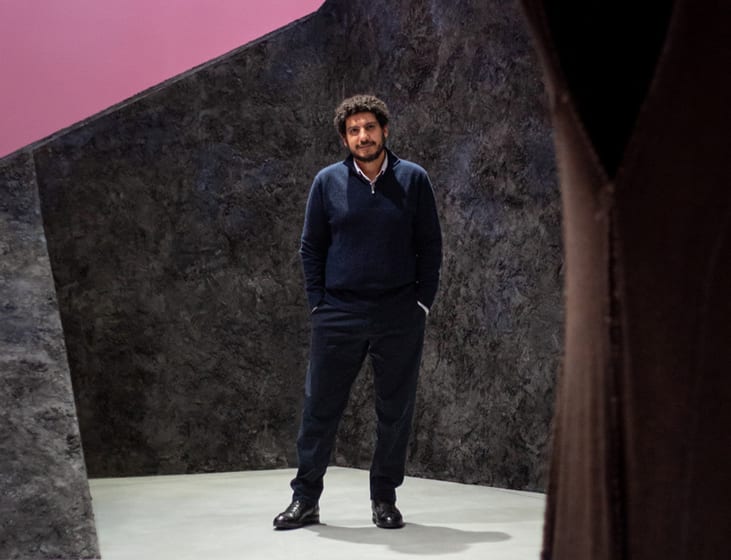
Wael Shawky. Image source: Lisson Gallery
Cameroon's Visionary Quest: Nemo Propheta in Patria
Cameroon is participating under "Nemo Propheta in Patria," featuring artists like Jean Michel Dissake, Hako Hankson, and Kendji & Ollo Arts at Palazzo Donà delle Rose, curated by Serge Achille Ndouma, Paul Emmanuel Loga Mahop and Sandro Orlandi Stagl.

Hako Hankson, Day of celebration (2023). Image source: Primo Marella Gallery
The Latin maxim "Nemo propheta in patria" (No one is a prophet in their land) casts light on the ubiquitous plight of those whose brilliance finds greater appreciation abroad than at home within their own communities.
It is important to mention that The Pavilion of the Republic of Cameroon blazes a trail as the first to craft a Carbon Net Zero exhibition at Venice Biennale, intertwining two bold strategies: implementing emission-slashing policies and embracing material recycling throughout the showcase.
Democratic Republic of Congo's Exploration: LITHIUM
While the Congolese collective ‘Cercle d’Art des Travailleurs de Plantation Congolaise (CATPC)’ is representing The Netherlands, the Democratic Republic of Congo (DMC) Pavilion stands ready to unveil its own exhibition under the theme "LITHIUM". Curated by Joseph Ibongo Gilungula, Michele Gervasuti, and James Putnam, the pavilion showcases the artistic practices of Aimé Mpane, Eddy Kamuanga Ilunga, Eddy Ekete, Jean Katambayi Mukendi, Cédric Sungo, Steve Bandoma, Eléonore Hellio, and Michel Ekeba from the Kongo Astronauts collective at the Gervasuti Foundation (Palazzo Canova, Cannaregio).
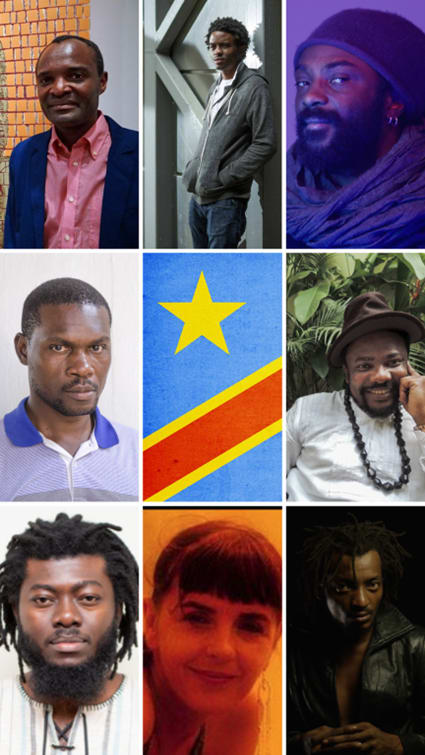
Artists Portraits. Image courtesy of the artists and artmedia
Ivory Coast's Melodic Expression: Blue Note
The Ivory Coast pavilion, titled "Blue Note" and led by Illa Ginette Donwahi and Simon Njami at the Centro Culturale Don Orione Artigianelli – Dorsoduro 947, presents the artistic endeavours of Jems Koko Bi, François Xavier Gbré, Sadikou Oukpedjo, Franck Abd-Bakar Fanny, and Marie Claire Messouma.
Kenya's Journey of Cultural Reclamation: Roots of Return
Kenya joins the essential summit of international contemporary art with its pavilion themed "Roots of Return," curated by Milka Mugo and Edward Mwaura Ndekere. The pavilion features artists Elkana Ong’esa, Gerald Oroo Motondi, Robin Okeyo Mbera, John Tabule Abuya Ogao, Peter Kenyanya Oendo, and Charles Duke Kombo.
Uganda's Collective Harmony: WE ARE ONE
The Uganda Pavilion invites visitors to immerse themselves in a collective exhibition, curated by Acaye Kerunen, that breaks down barriers hindering artists and artisans from entering the art world. Titled WAN ACEL | TULIBAMU | TURIBAMWE | WE ARE ONE, the exhibition features works by five individual artists and a twenty-six-person collective of weavers.
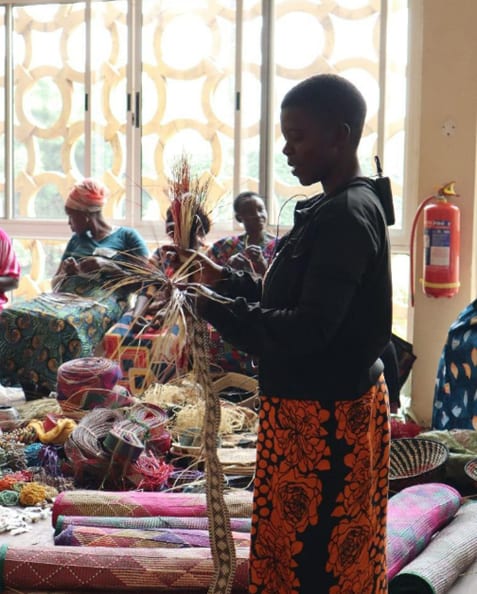
The Artisan Weavers Collective, Image source: Blum Gallery
Through an array of mediums such as bark cloth, black asper bamboo, paper beads, natural fibers, video installations, and sound, the pavilion offers a rich and diverse experience. Celebrating the interconnectedness of sculpture, architecture, materiality, and craftsmanship, it presents a nuanced narrative that unveils the essence of place within its temporal context.
Conclusion
From the debut of Benin, Ethiopia, Tanzania, and Senegal pavilions to the return of established voices like Nigeria and South Africa, the African presence at the Biennale is both diverse and dynamic. Each pavilion offers a unique lens through which to experience the complexities of African identity, heritage, and innovation.
The African pavilions at the Venice Biennale not only celebrate the continent's artistic heritage but also pave the way for a meaningful global-scale dialogue and exchange. Through the transformative power of art, the African pavilions at the Venice Biennale exemplify the ability to transcend borders and foster connections, offering a collective celebration of creativity and diversity.
